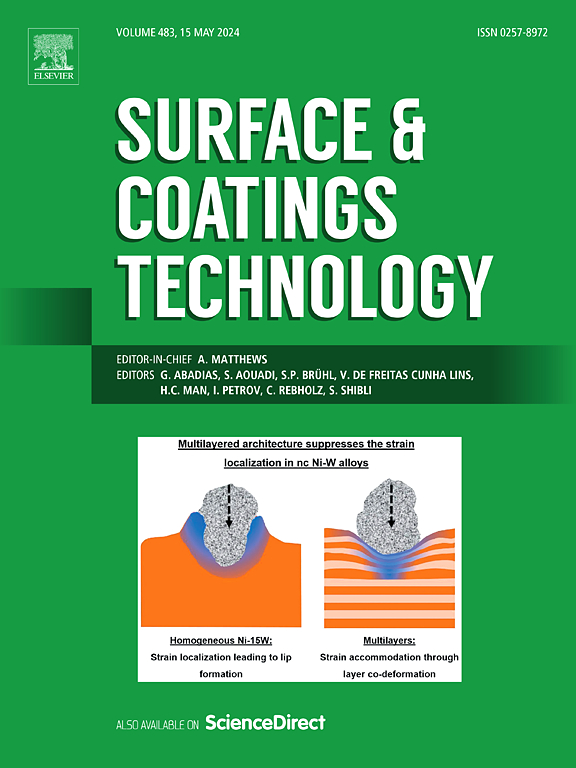Cracking and microstructure formation in laser cladded Ni60 coatings fabricated by circular and annular lasers: a comparative study
IF 5.3
2区 材料科学
Q1 MATERIALS SCIENCE, COATINGS & FILMS
引用次数: 0
Abstract
Laser cladding of Ni60 hard-facing coatings were fabricated using isogenous circular and annular laser beams. The microstructure and cracking susceptibility of these laser-deposited coatings were examined, along with the analysis of temperature and stress fields through finite element (FE) simulation. The comparative study showed that the coatings deposited by the annular laser, at laser power inputs ranging from1500 to 2000 W, exhibited significantly lower cracking susceptibility than those deposited by the circular laser. The FE simulation results reveled a more homogeneous molten pool temperature in the annular laser deposition over 1500 W, which resulted in a lower concentration of stress, lower volume fraction formation of chromium borides, higher volume fraction formation of chromium carbides. Additionally, a more dendritic growth pattern was observed, accompanied by an increase in crystal grain size, which in turn led to a refinement in the chromium carbides crystal dimensions and a decrease in the occurrence of grain boundary formation in annular laser deposited coatings. This structural arrangement attributed to a decrease in hardness and stress concentration, substantially depressing the cracking susceptibility. And therefore, cracking-free coating with acceptable hardness loss was successfully achieved using the annular laser at 2000 W laser power input.

圆形和环形激光熔覆Ni60涂层的开裂和微观结构形成:比较研究
采用均质圆形和环形激光束制备了Ni60硬质镀层的激光熔覆。通过有限元模拟分析了涂层的温度场和应力场,分析了涂层的微观结构和开裂敏感性。对比研究表明,在1500 ~ 2000 W的激光功率范围内,环形激光器沉积的涂层的开裂敏感性明显低于圆形激光器沉积的涂层。有限元模拟结果表明,在1500 W以上的环形激光沉积过程中,熔池温度更加均匀,导致应力浓度更低,硼化铬生成体积分数更低,碳化铬生成体积分数更高。此外,观察到更多的枝晶生长模式,伴随着晶粒尺寸的增加,这反过来导致碳化铬晶体尺寸的细化和晶界形成的发生减少。这种结构安排归因于硬度和应力集中的降低,大大降低了开裂敏感性。因此,在2000 W的激光功率下,环形激光器成功地获得了硬度损失可接受的无裂纹涂层。
本文章由计算机程序翻译,如有差异,请以英文原文为准。
求助全文
约1分钟内获得全文
求助全文
来源期刊

Surface & Coatings Technology
工程技术-材料科学:膜
CiteScore
10.00
自引率
11.10%
发文量
921
审稿时长
19 days
期刊介绍:
Surface and Coatings Technology is an international archival journal publishing scientific papers on significant developments in surface and interface engineering to modify and improve the surface properties of materials for protection in demanding contact conditions or aggressive environments, or for enhanced functional performance. Contributions range from original scientific articles concerned with fundamental and applied aspects of research or direct applications of metallic, inorganic, organic and composite coatings, to invited reviews of current technology in specific areas. Papers submitted to this journal are expected to be in line with the following aspects in processes, and properties/performance:
A. Processes: Physical and chemical vapour deposition techniques, thermal and plasma spraying, surface modification by directed energy techniques such as ion, electron and laser beams, thermo-chemical treatment, wet chemical and electrochemical processes such as plating, sol-gel coating, anodization, plasma electrolytic oxidation, etc., but excluding painting.
B. Properties/performance: friction performance, wear resistance (e.g., abrasion, erosion, fretting, etc), corrosion and oxidation resistance, thermal protection, diffusion resistance, hydrophilicity/hydrophobicity, and properties relevant to smart materials behaviour and enhanced multifunctional performance for environmental, energy and medical applications, but excluding device aspects.
 求助内容:
求助内容: 应助结果提醒方式:
应助结果提醒方式:


